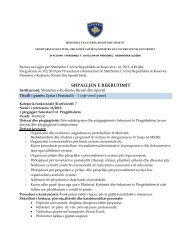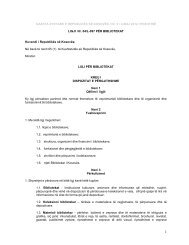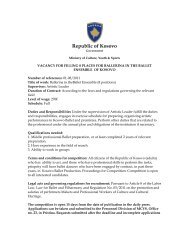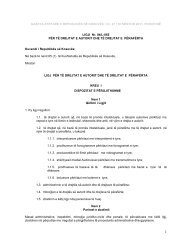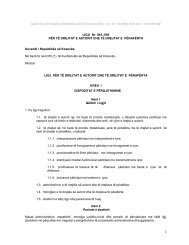Archaeological Guide of Kosovo
Archaeological Guide of Kosovo
Archaeological Guide of Kosovo
Create successful ePaper yourself
Turn your PDF publications into a flip-book with our unique Google optimized e-Paper software.
Vindenis<br />
147<br />
145<br />
146<br />
Among three road stations that were constructed in Dardania during<br />
the Roman Period, Statio Vindenis, is one <strong>of</strong> the identified stations. This<br />
archaeological site is set at the area <strong>of</strong> the village <strong>of</strong> Glavnik, Municipality <strong>of</strong><br />
Podujeva (Besiana). The site is located approximately 5km south, southeast<br />
from Podujeva. The ancient Via Lissus-Naissus (Lezha-Nish) roman road was<br />
a diagonal route, connecting the central Balkans region with the Adriatic coast,<br />
which passed through Vindenis. The settlement and roman road station <strong>of</strong> Vindenis<br />
are stretched on the right bank <strong>of</strong> Llap River vicinity, measuring an area<br />
<strong>of</strong> more or less <strong>of</strong> 15-20 hectares. During the eighties <strong>of</strong> the last century, systematic<br />
archaeological excavations carried out at this site, uncovered an area in<br />
total <strong>of</strong> 550 m2. Among recorded archaeological findings and features here, the<br />
most characteristic ones are the grave burials with the grave goods. The burial<br />
rites documented here, tell us about the practise <strong>of</strong> cremation and inhumation<br />
burial rites. Besides, a few tons heavy marble sarcophagus was discovered, most<br />
probably especially prepared for a distinguished person <strong>of</strong> high economical,<br />
social and political status. Nonetheless, archaeological investigations identified<br />
several dwellings, and in particular a distinguished discovery <strong>of</strong> a floor mosaic<br />
composed with geometrical motifs, at the central part <strong>of</strong> the mosaic, the figural<br />
display panel <strong>of</strong> the Orpheus, makes this mosaic a special discovery, A special<br />
finding discovered at this site, is a gold wedding ring (fig. 149) with a cameo<br />
which clearly indicates shaking <strong>of</strong> the right hands (dextrarum iunction),<br />
which means an agreement but also symbolizes loyalty and friendship. Geophysical,<br />
geomagnetic surveys or prospection’s conducted at this locality in<br />
2008 and 2011, in an area <strong>of</strong> at least 11 hectares <strong>of</strong> this important archaeological<br />
site, identified traces <strong>of</strong> remains <strong>of</strong> different objects that at the first<br />
impression, resemble to a military field garrison, most probably stationed<br />
there to protect the surrounding area and the road station. The archaeological<br />
site <strong>of</strong> Vindenis, was active during the entire period <strong>of</strong> the roman rule as<br />
well as during the late antiquity.<br />
Lab<br />
148<br />
149<br />
Podujevo<br />
Vindenis (Glavnik)<br />
Batlava<br />
Fig. 145. The Mosaic <strong>of</strong> Orpheus from Vindenis. (KM)<br />
Fig.146. Marble sarcophagus discovered in Videnis. (KM)<br />
Fig. 147. The site setting <strong>of</strong> the Vindenis.<br />
Fig. 148. Glass jar (KM)<br />
fig.149. Golden ring from Vindenis (KM).<br />
62 <strong>Archaeological</strong> <strong>Guide</strong> <strong>of</strong> <strong>Kosovo</strong>





